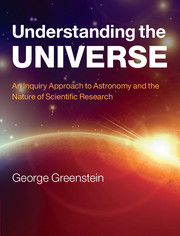Book contents
- Frontmatter
- Contents
- Preface
- Acknowledgments
- Part I Introducing steps to astronomy
- Part II The Solar System
- 6 Introducing the Solar System
- 7 The inner Solar System
- 8 The outer Solar System
- 9 Smaller bodies in the Solar System
- 10 Planets beyond the Solar System
- Part III Introducing stars
- Part IV Introducing galaxies and the Universe
- Epilog
- Appendix I The small-angle formula
- Appendix II Exponential notation
- Appendix III The Solar System
- Appendix IV The closest and brightest stars
- Appendix V Physical and astronomical constants
- Appendix VI Conversion factors
- Appendix VII Constellation maps
- Glossary
- Figure Credits
- Index
- Plate section
6 - Introducing the Solar System
from Part II - The Solar System
Published online by Cambridge University Press: 05 February 2013
- Frontmatter
- Contents
- Preface
- Acknowledgments
- Part I Introducing steps to astronomy
- Part II The Solar System
- 6 Introducing the Solar System
- 7 The inner Solar System
- 8 The outer Solar System
- 9 Smaller bodies in the Solar System
- 10 Planets beyond the Solar System
- Part III Introducing stars
- Part IV Introducing galaxies and the Universe
- Epilog
- Appendix I The small-angle formula
- Appendix II Exponential notation
- Appendix III The Solar System
- Appendix IV The closest and brightest stars
- Appendix V Physical and astronomical constants
- Appendix VI Conversion factors
- Appendix VII Constellation maps
- Glossary
- Figure Credits
- Index
- Plate section
Summary
People used to think that the Solar System was essentially the entire Universe, and that beyond its bounds lay little more than “lots of stars.” We now know this is not so, and that the full astronomical Universe is far richer than that. Our Solar System is one among many, one small part of the whole. I like to think of it as our astronomical home base: the “house” in which we live.
We will begin to study our “house” by considering its most general features. We will ask how big it is and how massive; and what the orbits are of the bodies within it. The Solar System turns out to have a strikingly regular shape, and the planets within it divide naturally into two groups: inner and outer. In subsequent chapters we will focus more closely on its individual members.
Measuring the Solar System
In Part I of this book we prepared ourselves for our study of astronomy. In particular, we amassed a set of tools that we can use to measure various properties of the Universe. Let us now use these tools to find:
(1) the size of the Solar System,
(2) the sizes of the Sun and planets,
(3) the masses of the Sun and planets.
(1) The size of the Solar System
To measure the size of the Solar System we need to measure the sizes of orbits within it. We will begin by measuring the size of our orbit, and then move on to that of the planets.
- Type
- Chapter
- Information
- Understanding the UniverseAn Inquiry Approach to Astronomy and the Nature of Scientific Research, pp. 161 - 173Publisher: Cambridge University PressPrint publication year: 2013



